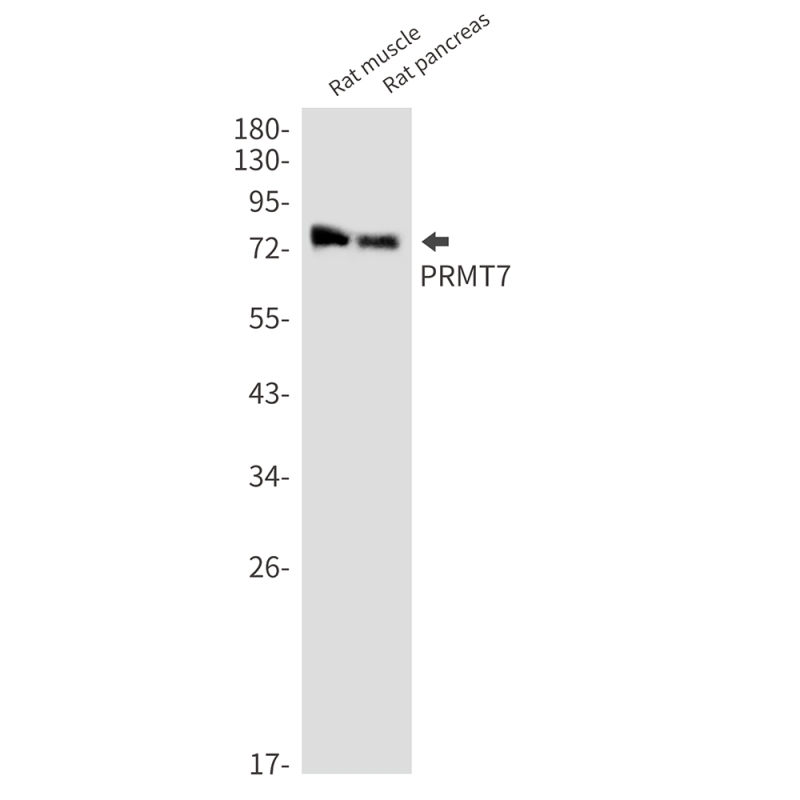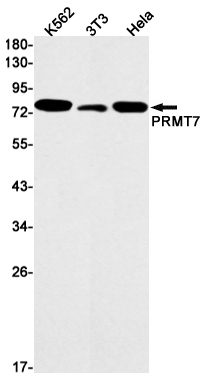

| WB | 1/500-1/1000 | Human,Mouse,Rat |
| IF | 咨询技术 | Human,Mouse,Rat |
| IHC | 咨询技术 | Human,Mouse,Rat |
| ICC | 技术咨询 | Human,Mouse,Rat |
| FCM | 咨询技术 | Human,Mouse,Rat |
| Elisa | 咨询技术 | Human,Mouse,Rat |
| Aliases | SBIDDS |
| Entrez GeneID | 54496 |
| WB Predicted band size | Calculated MW: 78 kDa; Observed MW: 78 kDa |
| Host/Isotype | Rabbit IgG |
| Antibody Type | Primary antibody |
| Storage | Store at 4°C short term. Aliquot and store at -20°C long term. Avoid freeze/thaw cycles. |
| Species Reactivity | Human,Mouse,Rat |
| Immunogen | A synthetic peptide of human PRMT7 |
| Formulation | Purified antibody in TBS with 0.05% sodium azide,0.05%BSA and 50% glycerol. |
+ +
以下是3篇关于PRMT7抗体的参考文献及其摘要概括:
---
1. **文献名称**: "PRMT7. a new protein arginine methyltransferase that synthesizes symmetric dimethylarginine"
**作者**: Lee J. et al. (2005)
**摘要**: 该研究首次克隆并鉴定了PRMT7的酶活性,证明其催化精氨酸对称二甲基化。文中开发了特异性PRMT7抗体,并通过免疫印迹验证其在多种组织中的表达模式,揭示其在表观遗传调控中的潜在作用。
---
2. **文献名称**: "A critical role for protein arginine methyltransferase Prmt7 in the maintenance of a pluripotent state in early mouse development"
**作者**: Gonsalvez G.B. et al. (2014)
**摘要**: 利用PRMT7抗体研究其在早期胚胎发育中的功能,发现Prmt7缺失导致胚胎干细胞多能性丧失。抗体用于检测蛋白表达及亚细胞定位,揭示PRMT7通过调控靶基因甲基化维持干性。
---
3. **文献名称**: "Protein arginine methyltransferase 7 regulates cellular invasion through upregulation of MMP9 expression"
**作者**: Mirza S. et al. (2016)
**摘要**: 研究PRMT7在肿瘤侵袭中的作用,使用特异性抗体证明其通过上调MMP9促进癌细胞转移。通过免疫沉淀和Western blot分析,揭示PRMT7-MMP9通路作为潜在治疗靶点。
---
(注:若需更多文献,可补充Pawlak等关于PRMT家族综述或近年机制研究。)
PRMT7 (Protein Arginine Methyltransferase 7) is a member of the PRMT enzyme family, which catalyzes the post-translational methylation of arginine residues in proteins. Classified as a Type II enzyme, PRMT7 primarily generates monomethylarginine (MMA) marks, distinguishing it from other PRMTs that produce asymmetric or symmetric dimethylarginine. It plays a multifaceted role in epigenetic regulation, chromatin remodeling, DNA damage repair, and cellular differentiation. Structurally, PRMT7 contains two adjacent methyltransferase domains, a unique feature among PRMTs, which may contribute to its substrate specificity or catalytic regulation.
PRMT7 is implicated in diverse physiological and pathological processes, including embryonic development, metabolism, and cancer. Studies link its dysregulation to tumor progression, neurodevelopmental disorders, and metabolic syndromes, though its exact mechanisms remain under investigation. Antibodies targeting PRMT7 are critical tools for studying its expression, localization, and molecular interactions. They are widely used in techniques like Western blotting, immunofluorescence, immunohistochemistry, and co-immunoprecipitation. However, developing specific PRMT7 antibodies is challenging due to high homology within the PRMT family. Rigorous validation using knockout cell lines or siRNA-mediated knockdown is essential to confirm antibody specificity and avoid cross-reactivity with other PRMTs (e.g., PRMT5 or PRMT9). Commercial PRMT7 antibodies often target unique regions, such as the N-terminal domain, to enhance specificity. These reagents have advanced research into PRMT7’s role in gene silencing, spliceosome regulation, and its tissue-specific expression patterns across organs.
×